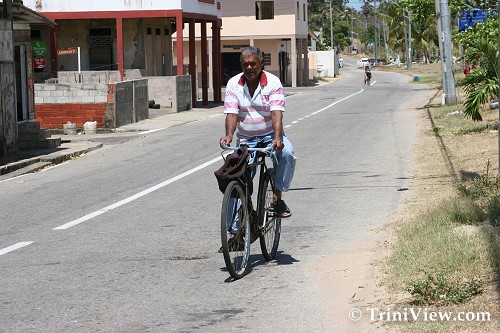 Riding along the main road in Bonasse Village, Cedros
Riding along the main road in Bonasse Village, Cedros
TriniView.com Reporters
Posted: May 05, 2007
Cedros, a coastal village which lies on a south-western peninsula on the island of Trinidad is a quiet village with a history steeped in colonialism much like the other villages in Trinidad and Tobago. The village lies approximately 8 miles off the coast of Venezuela and is one of the most unspoiled sites remaining in Trinidad and Tobago.
The village was so named by Spanish sailors who were bedazzled by the huge cedar trees that bordered one of the bays of the south-western peninsula. Hence the term 'cedros' which is the Spanish term for cedars.
The area was inhabited by Europeans after Spanish Governor Don José Maria Chacón had invited and granted them land under the Cedula of Population. However, by the time the British took over the island, there were only three land grants belonging to Torre, Consedor and Quorge.
The region was then called "Quemada" (which translates as "burnt" in English) until 1849 when Lord Harris divided the island into counties and wards changing many names in the process. The former name is very telling about the condition of the area which was subject, as it is today, to many fires that scorched the area, particularly during the dry season.
In 1849, East Indian laborers, who came to Trinidad five years prior, had entered into Cedros to fulfill their contracts as indentured laborers. The estates which they worked usually ran in a linear fashion from the beachfront into the interior.
Although most of the cedar trees had long ceased to exist, Lord Harris named the region around the village 'Ward of Cedros' and the settlement along the old Bay of Cedars was renamed Bonasse (although this area is referred to as Cedros).
When the British had arrived in 1797 to the island, they were of the view that Cedros was, according to Frederick Mallet, "...fit for sugar and coffee only." But later on in Cedros' history other crops such as cocoa and coconuts were grown there and in the case of coconuts, exists in abundance even up to today.
Although the British had established some sugarcane plantations, it's main export product was rum. By 1811, Cedros had 20 Whites, 41 "free Blacks", and 375 enslaved Africans totaling 436 in all. The seven distilleries that were in Cedros produced 2,260 gallons of rum annually which was a modest return on the sugarcane product.
Although other crops such as bananas were experimented with, it was coconut that was to dominate the Cedros economy.
By 1870, Cedros was still involved in sugar and cocoa production and had ceased all coffee production. The round the island steamer visited frequently to transport the produce.
Two churches were also erected during this year: an Anglican church and a Roman Catholic church.
In 1871, census reports show the Ward of Cedros as having a population of 3,500 (the village of Bonasse having the bulk of the population) which was excellent during a period when infant mortality was common as a result of diseases such as malaria.
The year 1874 brought to the village the first government school in the district. In 1880 there were only 123 attendants which was due to the fact that most of the village's children still laboured on the fields.
Cedros village, by 1881 contained 2,920 persons, 784 houses and 24 shops which showed a mildly significant increase of population, especially in a rural area. Teachers, priests and police officers were also becoming more popular in the village at this time as villages slowly moved to other forms of occupation. Spanish was still the main language spoken by the villagers at this time.
Today, agriculture does not play a big part in the economy of the area except for the coconut estates which are still abundant in the area. Currently, Cedros is known for being a fishing village which involves about three-quarters of the population. Popular forms of fishing in the area are filet fishing, trap-fishing and shrimp fishing. Seine fishing, which was once a very popular form of fishing involving many hands to pull in the nets has largely disappeared.
One issue that the fishermen constantly face is the dispute over territorial waters with neighboring Venezuela (only 8 miles away).
The village still possesses charming old fashioned qualities and is very picturesque. Some of the street names, which have historical bearing are Union Street, Sainte Marie Street, Hughes Street, Gardieu Street (the latter two are names of former proprietors), George Street, Edward Street and King Street (the last three are after the British aristocratic presence).
The population of Cedros has since declined with many moving into the more urban areas, possibly in the pursuance of other opportunities. However, it is still popular with Trinbagonians as a place for family outings and field trips.
Notes: "Towns and Villages of Trinidad and Tobago" by Michael Anthony
Coromandel, Cedros and Columbus Bay in pictures:
www.triniview.com/gallery/main.php?g2_itemId=172149
Homepage | Carnival | Special Events | Photo Gallery
|
